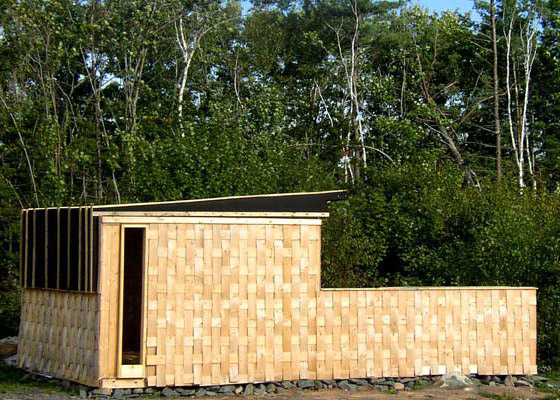How to use recycled materials to their advantage, and when not to
Salvaging objects from one product and transforming them into another has been done for millennia. Done well, it can not only be fun and an inspiration, it can also dramatically improve the sustainability of buildings and interiors. The following guiding principles explain what is a good re-use and what is not.
Using salvaged materials to recycle
There is a plethora of designer products that use salvaged materials as the basis for new designs, with the enthusiasm of a new creative paradigm. It may be a reaction to potential apocalypse, or just a new fad, but whatever the reason, it’s not difficult to find an example of salvage design in many recent exhibitions, publications and websites.
Where did the salvage design of today originate? Salvage design can be defined as products formed from "industrially produced consumer discards and their subsequent transformation" into new objects.1 That is, one person’s waste becomes another’s treasure. Its influence, through a consumerist society of indulgence, wealth and waste, knows no bounds. Neither geography, gender nor nationality bind this concept to any particular populace.
Obtaining salvaged materials
The variety of available goods made from salvaged trash is growing; there are also less ‘adventurous’ ways for integrating salvaged products and materials into everyday living. Buying secondhand items is an obvious and simple solution. There are increasing outlets for secondhand goods from sites like eBay and secondhand markets.
Many older pieces of furniture were built to last and have excellent ‘bones’ but may require ‘modernising’ with new upholstery or a fresh coat of paint. Traditional repairers such as upholsterers, clothing and electrical repair stores will become services of the past if
they are no longer used and this could in itself halt the secondhand market as a consequence. Some
entrepreneurs see the advantages of re-using materials, such as carpet tile manufacturers, who ‘refurbish’ old carpet tiles.
Building materials such as timber floor boards, windows and doors, bricks and even plasterboard sheets can be re-used if carefully dismantled at deconstruction, and are available for sale at building salvage depots. Projects may salvage materials on site, enthusiastically aiming to redesign whole buildings only using the materials from the original.
Problems from using salvaged materials
Using salvaged building materials can come with pitfalls – some, such as timber floor boards, can be more expensive than new due to the additional work needed to de-nail, or extra care required in salvaging so as not to break delicate timber tongues. Windows and doors may not fit into standard openings, so need to be selected at design stage to be designed into the building. Bricks do not always come in the squeaky clean and consistent colouring of new bricks but
with some creativity and imagination can form a new aesthetic.
The future in salvage design
Building materials like object materials don’t always
have to come from the building industry itself. In the book Superuse: Constructing New Architecture by Shortcutting Material Flows, Ed van Hinte, Césare Peeren and Jan Jongert suggest mapping local resources of waste products and materials from all industries within a defined zone. Using limited resources and imagination a new aesthetic and building construction may emerge from what was once seen as trash.
Is salvage design just a design fad or will it be part of the solution in creating a more sustainable future? Only time will tell. However, if Emily Campbell, Head of Architecture and Design at the British Council and co-curator of My World is correct, this may indeed be the future of design. “Designers increasingly sense and fear the apocalyptic use of the earth’s resources ... The quasi-alchemical transformation of certain familiar or banal industrial products and materials into artful new things is a strong current in contemporary ... design. It is no longer enough for a product to have form; now it must have content, a story to tell, a metaphorical force.”2
For now, these designs are taking unwanted materials and transforming them into useful and beautiful objects, transforming them again into objects of value, while reducing waste from our landfills and environments.
Salvage design websites
- D-Liscious and Escama
- Eco Depot
- Haul
- Jerry Kott
- Liana Kabel
- Margaux Lange
- Max McMurdo
- Naama Steinbock and Idan Friedman
- Second Time Around
- Secco
- Stuart Haygarth
- Thabto
- Vaho Works
The gentle art of deconstruction
Building materials and components can only be successfully re-used if their removal from the original building does them no harm.
Some materials, like bricks, may pass through the demolition process relatively unscathed, further enhancing the amortisation of their embodied energy. Other materials, like framing timber, require some care if the individual members are to be granted another life, which structurally, they are very likely to be able to do. Some materials, like windows or floorboards, require a very gentle touch or any value they have will be shattered – literally – in a second.
The common technique is to crush the old house into a giant pile of rubble in the middle of the site, where it is loaded onto trucks and sent to landfill. This is utterly irresponsible, and must cease as a general rule, although there will be some cases where it may be appropriate. But these will be rare.
Deconstruction – tile by tile, brick by brick, stick by stick – is simply the reverse of the way most houses are currently built. The actual techniques require little explanation – every builder and tradesperson knows how to do it.
Many claim it is uneconomic, but are happy to use the same millennium-old technique to rebuild. It is suggested the new build would be better served using modern preconstruction techniques (modular and/or flat-pack). Deconstructing the old at the very least provides work for more people than a single excavator operator, while recovering so much material in the process. These materials can be used in other renovations if not on site in the new build.
Learn more by buying the entire book
This article is one of many useful articles in the book entitled "How to rethink building materials". The book can be purchased online as a hard copy or soft copy (e-book).
Table of contents - "How to rethink building materials"
- Part 1 Overview: What it's all about
- 1.01 Creating sustainable change - Barriers to getting the message through.
- 1.02 Choosing materials from an early design stage - Questions to ask at the beginning of a project.
- 1.03 Managing change - How to avoid the downside of the building industry's inherent aversion to risk.
- Part 2 Forethought: A look at the issues behind the choices we make
- Part 3 Planning: Unfamiliar but essential considerations
- Part 4 The Great Debates: Contested ideas about material impacts
- Part 5 Uncommon Solutions: The fast-approaching horizon
- Part 8 A-Z of Building Materials


